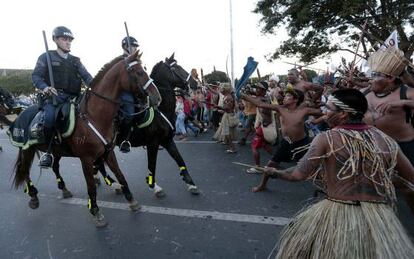Brazilian indigenous tribes join anti-World Cup demonstrations
Protestors in Brasilia use bows and arrows to defend themselves against police tear gas Public transportation workers announce strike in Rio de Janeiro

Various activist groups held marches throughout Brazil against the upcoming World Cup on Tuesday. In Brasilia, indigenous people dressed in traditional attire joined the other groups that have been protesting against the tournament for months. As protestors and police clashed, the officers used tear gas and rubber bullets to disperse the crowd. The indigenous groups defended themselves with bows and arrows.
Brazilian Military Police say about 2,500 people participated in the march in the capital. These included members of various indigenous tribes and activists from the homeless workers’ movement. Among the protestors’ demands were for land surveys demarcating areas belonging to indigenous communities to be resumed; housing for people who have been displaced by the construction of World Cup stadiums; the repeal of tax exemptions for Fifa and its commercial partners; the demilitarization of the police; and an end to police brutality against activist groups.
The indigenous people had come to Brasilia to participate in a national conference on Thursday, but, according to Articulação dos Povos Indígenas do Brasil (APIB), an umbrella group for various indigenous organizations, those who joined the protests felt “that the cause concerned all Brazilians.”
The police say one officer suffered light injuries from an arrow
Clashes erupted as the crowd marched toward Mané Garrincha National Stadium where the World Cup trophy was on display. The cup had to be transferred to another location for security reasons. The police launched tear gas and fired rubber bullets at the protestors. The indigenous people tried to defend themselves with bows and arrows against the 700 security officers on duty. The police say one officer suffered light injuries from an arrow, while the APIB says at least six indigenous leaders were hit with rubber bullets.
Although the World Cup has become the main target of all the demonstrations, many activist movements have a regular schedule of protests to hold whether there is a championship or not. The national indigenous conference takes place every year, while teachers and government workers often hold demonstrations, though these are more frequent during election season.
In São Paulo, public school teachers and government workers continued their 35-day strike. According to the police, 2,300 people marched on Tuesday, blocking off a section of Paulista Avenue. Teachers are calling for an immediate 15.38 percent increase in salaries. The Brazilian government has already agreed to the raise, but it will not be effective until next year.
Meanwhile, Rio bus drivers began a 24-hour strike on Tuesday, while doctors within the public healthcare network in Belo Horizonte (Minas Gerais) stopped practicing for 48 hours. This protest marks healthcare workers’ third call for higher pay and better work conditions in the last three weeks.
Translation: Dyane Jean François
Tu suscripción se está usando en otro dispositivo
¿Quieres añadir otro usuario a tu suscripción?
Si continúas leyendo en este dispositivo, no se podrá leer en el otro.
FlechaTu suscripción se está usando en otro dispositivo y solo puedes acceder a EL PAÍS desde un dispositivo a la vez.
Si quieres compartir tu cuenta, cambia tu suscripción a la modalidad Premium, así podrás añadir otro usuario. Cada uno accederá con su propia cuenta de email, lo que os permitirá personalizar vuestra experiencia en EL PAÍS.
¿Tienes una suscripción de empresa? Accede aquí para contratar más cuentas.
En el caso de no saber quién está usando tu cuenta, te recomendamos cambiar tu contraseña aquí.
Si decides continuar compartiendo tu cuenta, este mensaje se mostrará en tu dispositivo y en el de la otra persona que está usando tu cuenta de forma indefinida, afectando a tu experiencia de lectura. Puedes consultar aquí los términos y condiciones de la suscripción digital.









































